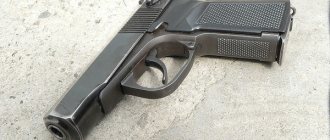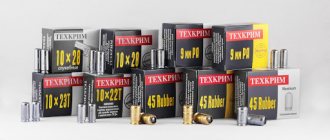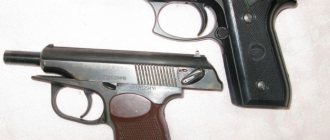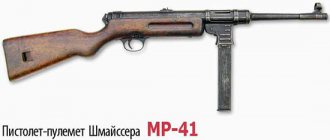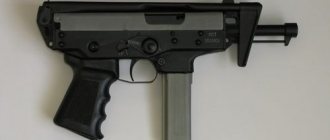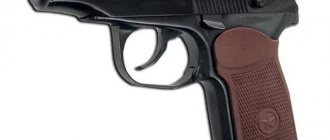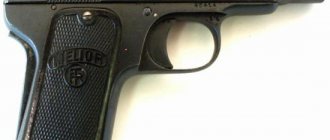The operation of a free shutter using the example of a pistol. I
- position before the shot;
II
- the pressure of the powder gases has exceeded the boost pressure, the bullet crashes into the rifling of the barrel, but the cartridge case, held by the inert mass of the bolt and the friction of the walls tightly pressed by pressure to the chamber, moves back only a few millimeters;
III
- the bullet leaves the barrel, during the same time the cartridge case came out of the chamber only with its thickened part at the base;
IV, V
- the pressure in the barrel drops, the friction in the chamber decreases sharply, and the sleeve moves back under the influence of residual pressure and inertia, pushing the bolt, thereby activating the automatic reloading.
blowback
, or
inertial bolt
- a longitudinally sliding bolt that is not engaged with a stationary barrel during a shot.
Blowback recoil
— the principle of operation of automatic reloading of firearms, in which the longitudinally sliding bolt is not engaged with a stationary barrel, and its retreat when fired is slowed down mainly by the friction force of the walls of the cartridge case on the chamber and the large mass of the bolt itself.
A blowback bolt is structurally simpler than any other type of barrel locking. However, it is characterized by such significant disadvantages as excessive weight of the weapon, a tendency to a high rate of fire and an increase in weapon vibrations when firing in bursts due to the rapid reciprocating movement of the massive bolt and its impacts in extreme positions, which also contributes to accelerated wear of the weapon.
Due to its simplicity, the blowback design was widely used in submachine guns in the past: just to name examples such as MP18, Suomi, MP40, PPSh, PPS, STEN, Uzi and many others. Currently, many submachine guns use more advanced mechanisms with a semi-blowback or even removal of powder gases, although the blowback also remains very popular among designers of this type of weapon.
In addition, a blowback bolt is very often used in another type of weapon chambered for a pistol cartridge - pistols, usually using relatively low-power cartridges (APS, PSM, Browning and others), since the mass of the pistol bolt casing is usually much less than can weigh the bolt of a submachine gun.
Finally, self-loading hunting rifles and carbines chambered for small-caliber rimfire cartridges, for example TOZ 99, Ruger 10/22 and similar, usually have a blowback action.
The use of this scheme in other types of weapons is usually only sporadic.
Operating principle
At the base of the cartridge case there is a thickened part in which the primer is located.
The task of the designer of a blowback system is to ensure that during the time that the bullet is in the bore, the cartridge case leaves the chamber by an amount not exceeding the length of this part. When fired, the powder gases simultaneously exert pressure on the bullet, on the walls of the cartridge case and on its bottom - the latter component is transferred to the bolt. In this case, several multidirectional forces arise:
- The pressure force of the powder gases on the bullet tries to push it forward from the barrel, through the muzzle;
- The pressure force on the bottom of the cartridge case tries to push it out of the chamber back, through the breech section of the barrel, which is prevented by the massive bolt supporting the cartridge case from behind;
- The force of pressure on the walls of the cartridge case presses them tightly against the walls of the chamber, resulting in the appearance of a frictional force between the walls of the case and the walls of the chamber, preventing the cartridge case from leaving it.
As a result of the combined influence of these forces, both the bullet and the cartridge case begin to move in opposite directions, but at different speeds: if the speed of the bullet near the muzzle reaches 300-500 m/s when using pistol cartridges, then the highest shutter speed usually does not exceed 4 m/s With.
The parameters of the system (barrel length, mass of the bullet and bolt, surface area of the sleeve, and so on) are selected by the designers in such a way that during the time it takes for the bullet to pass along the barrel bore to the muzzle, the shutter has time to move only a few millimeters, while the sleeve comes out of the chamber only with its thickened part, in which the capsule is located, which protects it from rupture.
After the bullet leaves the barrel, the pressure in its bore drops and the cartridge case is completely released from the chamber, pushing the bolt. Removing the cartridge case in a blowback system occurs, therefore, practically without the participation of an ejector mounted on the bolt - it only holds it in the bolt cup, and does not “pull” it out of the chamber, as in other systems. In principle, a blowback system can do without an ejector - it is needed only in case of a misfire to remove a failed cartridge from the barrel. There were samples of weapons with a blowback (for training or sports and entertainment purposes) that did not have an ejector to simplify the design.
The accumulated energy of the bolt is enough to ensure the operation of the weapon’s automation.
This description of the operation of a blowback system is simplified. In practice, in a weapon with a blowback, in which the firing pin has the form of a part fixedly fixed to the bolt mirror, the primer of the next cartridge is punctured even before it is completely entered into the chamber and the bolt comes to the extreme forward position, as a result of which the movement of the bolt back is additionally counteracted by inertia of forward movement of the moving parts of the weapon. Using this principle (the so-called “roll-out shutter”
, in English terminology -
advanced primer ignition
) allows you to reduce the rate of fire and somewhat reduce the required mass of moving parts of the weapon. At the same time, however, it should be taken into account that if a lingering shot occurs during shooting - slow firing of a defective or damaged during storage cartridge - the shot will occur after the bolt has fully reached the forward position and stopped, so that the inertia of its forward movement will not counteract its retreat back, so the designer must provide sufficient mass of the bolt in order to ensure the safety of the shooter and the safety of the weapon even in such a development of events.
The use of a bolt rollout somewhat reduces the reliability of the weapon's automatic operation, and also allows firing exclusively from an open bolt ("from the rear sear"), which is not always acceptable due to a decrease in the accuracy of fire, especially single fire. However, this principle is de facto used in most blowback submachine guns (having a firing pin fixedly fixed in the bolt cup), in particular, Uzi, PPSh, PPS, and so on. In the MP40 submachine gun, the firing pin is made separately from the bolt, as part of a striker-type firing mechanism, but the bolt rollout is also used thanks to a special device of the latter, designed in such a way that the firing pin strikes the primer an instant before the bolt comes to the forward position. The same principle was used, for example, in the early version of the 12-gauge Atchisson assault shotgun (AAS - Atchisson assault shotgun), which successfully made it possible to use a powerful hunting cartridge in automatic weapons with a blowback.
In a more complex version, the same principle was implemented even in some light blowback guns, or, for example, in the Swiss 20 mm anti-tank rifle
. There is even a project for a future weapon based on this principle with a very simple but effective design.
Blowback action in light guns. Wafer chuck and chuck with reduced flange.
A significant advantage of a blowback action is that it only experiences compression deformation when fired. Many types of materials can successfully withstand this deformation, which makes it possible to use relatively low-strength, but cheap and easy-to-process materials for the manufacture of a free shutter - unhardened low-carbon steel, cast aluminum bronze (like part of the British STEN-a), zinc-aluminum cast alloy ZAMAK (pistols and carbines from Hi-Point Firearms), and so on. At the same time, the durability of the weapon suffers somewhat - with a large round of fire, hardening appears on its parts, which does not improve performance, and the problem of durability can be partly eliminated by the use of buffers that soften the rollback of moving parts to the rear position. For comparison, for example, when the bolt is locked by turning, its lugs experience shear deformation during a shot, to counter which very high-quality carbon or alloy steel is required (in the practice of the domestic arms industry, carbon spring steels 50A, 50PA or similar are used; abroad the standard for The weapon industry considers chrome-molybdenum steel ANSI 4130 ChroMoly or similar) that has undergone heat treatment.
Basic schemes of operation of automation
A.B. Beetle "Small Weapons"
Systems without bolt-barrel engagement
Scheme 1
. Using recoil with a free bolt and a stationary barrel. The bolt is held in its forward position by a spring, and when fired, the recoil throws it back without hindrance. Possessing much more mass than the bullet, the bolt moves much slower than it, so even before the cartridge case leaves the chamber, the bullet has time to leave the barrel and the pressure in the barrel decreases sharply. The shutter returns to its original position under the action of the return spring.
Scheme 2
. Using the energy of powder gases with a forward moving barrel and a stationary bolt. The recoil affects the stationary body and is not used in any way. Reloading is carried out by moving the barrel forward under the action of friction that occurs as the bullet passes through the barrel, and backward under the action of the return spring.
Semi-blowback systems
Scheme 3
. Systems with semi-free shutters occupy an intermediate place between systems with free and linked shutters. There is no rigid locking of the barrel, and slowing down the opening of the bolt during a shot is achieved with the help of devices that increase friction or cause accelerated waste of other parts. The scheme shown here was implemented on a Heckler-Koch pistol, P-9S. Moving backwards under the action of recoil, the shutter carries two rollers with it. The backward movement of the rollers is accompanied by their approach, which is accelerated by the withdrawal of the striker and slowed down the withdrawal of the bolt.
Interlocked valve systems
Scheme 4
. Using recoil with a long barrel stroke. The bolt and barrel are firmly interlocked during a shot, so the recoil pulls them back the entire length of the recoil. After the moving parts reach the rearmost position, the bolt and barrel are disengaged and subsequently returned forward. When the barrel moves forward, the cartridge case is extracted, and when the bolt moves, the cartridge is chambered and the locking device is activated.
Scheme 5
. Using recoil with a short barrel stroke. The barrel and bolt, being rigidly linked to each other using a locking device, move back under the action of recoil. Since together they have a relatively significant mass, their waste occurs relatively slowly. Soon after the moving parts begin to withdraw, the locking device, interacting with the stationary body, turns off and releases the bolt. The barrel stops after a short retreat, and the bolt continues the movement necessary to reload the pistol. Locking devices with a short barrel stroke can be very diverse. See diagrams of some of them here.
Diagram of a blowback submachine gun
Despite all the variety of external forms, the principle of operation of automation in almost all submachine guns is the same - the use of blowback recoil. Only a few samples had semi-free shutters. A submachine gun ready to fire has the next cartridge not in the chamber, but in the magazine, its barrel is empty, and the bolt is in the rear position (open). When you press the trigger, the bolt is released, which, under the action of the recoil spring, begins to move forward, captures the cartridge from the magazine, sends it into the chamber and punctures the primer. 1 - trunk; 2 - shutter; 3 — return spring; 4 — trigger mechanism; 5 - bolt box; 6 - casing; 7 - store.
Automation scheme based on the removal of gases from the barrel bore
The bullet passes the gas outlet hole, part of the powder gases rushes into it and throws back the gas piston, the rod of which, acting on the locking device, releases the bolt and allows it to move back freely under the influence of the residual pressure of the powder gases. The bolt moving back cocks the firing mechanism, ejects the spent cartridge case, and compresses the return spring. In self-loading weapons or automatic weapons with a fire selector set to single fire, it also includes a disconnector. When the bolt moves forward under the action of the return spring, the next cartridge is chambered from the magazine. 1 - trunk; 2 - shutter; 3 — gas outlet device (gas chamber, piston and rod); 4 — locking device; 5 — trigger mechanism; 6 - disconnector; 7 - store.
Dynamics of blowback weapons
The operation of a blowback system requires that the pressure force of the powder gases at the bottom of the cartridge case be greater than the total force resisting the rear movement of the bolt, which has the following components:
- the resistance force of the return spring pressing the bolt against the barrel cut;
- the frictional force between the bolt and the walls of the bolt box, or the guides along which it moves;
- friction force between the walls of the cartridge case and the walls of the barrel chamber.
- the inertial force of the shutter, varying in proportion to the change in its mass.
The first two components are negligible compared to the last [1].
Thus, the condition for the operation of a blowback system takes the following form:
PS > R , {\displaystyle PS>R,}
where:
P
is the gas pressure inside the liner;
S
is the area of the sleeve bottom;
R
is the friction force of the cartridge case in the chamber.
For a cylindrical sleeve with uniform wall thickness, this condition, after substituting the appropriate formulas for calculating the area of the bottom of the sleeve and the friction force of its walls on the chamber, takes the following form:
ld 1 < 1 48 ( d 1 d ) 2 , {\displaystyle {\frac {l}{d_{1}}}<{\frac {1}{48\left({\frac {d_{1}}{ d}}\right)^{2}}},}
where: d {\displaystyle d} is the inner diameter of the sleeve; d 1 {\displaystyle d_{1}} — outer diameter of the sleeve; l {\displaystyle l} is the length of the case body.
From this formula it is clear that if the length of the cartridge case exceeds a certain limit value, then even with a low mass of the bolt the system will not work, since the cartridge case will remain in the chamber when fired and will most likely receive a transverse rupture, which will lead to jamming of the weapon and may cause injury arrow. The risk of such a development is especially high when using cartridges with a high bottle ratio due to the fact that powder gases put pressure both on the bottom of such a cartridge and on its slope from the inside.
In addition, to ensure normal operation of a blowback system, it is necessary that during the shot (that is, before the bullet leaves the barrel), the bolt together with the cartridge case moves back a certain amount - usually no more than 2 mm, which corresponds to the length the thickened part of the sleeve in which the primer is located and on which the annular groove is located. If this condition is violated, a longitudinal rupture of the cartridge case is likely, since until the bullet leaves the barrel, a high residual pressure of the powder gases remains in it.
Reducing the shutter path during a shot is achieved in a blowback system by increasing the mass of the moving parts of the weapon, which are usually represented only by the shutter itself in the form of a non-separable part.
In the design of weapons, an evaluative empirical similarity formula has been adopted, which makes it possible to roughly, with some overestimation (due to the lack of taking into account the friction forces and resistance of the return spring), estimate the mass of moving parts of a blowback weapon, necessary to ensure the normal operation of its automatic reloading:
Q = L ql , {\displaystyle Q={\frac {Lq}{l}},}
where: Q {\displaystyle Q} is the mass of moving parts; q {\displaystyle q} — bullet mass; l {\displaystyle l} is the path traveled by the bolt while the bullet is in the barrel; L {\displaystyle L} is the length of the rifled part of the barrel.
There is another version of the empirical relationship for approximate determination of the required mass of the shutter:
Q = q + 0.5 wx 1 L , {\displaystyle Q={\frac {q+0.5w}{x_{1}}}L,}
where: Q {\displaystyle Q} is the mass of moving parts; q {\displaystyle q} — bullet mass; x 1 {\displaystyle x_{1}} - the path traveled by the bolt while the bullet is in the barrel; L {\displaystyle L} - length of the rifled part of the barrel; w {\displaystyle w} is the mass of the powder charge in the cartridge.
Foreign literature also provides the following estimation formula for determining the required mass of the free shutter:
M = 1 , 09 ⋅ 10 − 5 ⋅ m V b ( D d ) 2 , {\displaystyle M=1.09\cdot 10^{-5}\cdot mV_{b}\left({\frac {D} {d}}\right)^{2},}
where: M {\displaystyle M} is the mass of moving parts in pounds; m {\displaystyle m} is the mass of the bullet in pounds; V b {\displaystyle V_{b}} - bullet speed in feet per second; D {\displaystyle D} is the diameter of the shutter mirror in inches; d {\displaystyle d} is the bullet base diameter in inches.
Naturally, the values obtained from these formulas are purely indicative in nature - in real design practice, significantly more complex calculations are used using the apparatus of higher mathematics, supplemented by extensive practical material obtained in the process of finishing the sample. In addition, the mass of the bolt also depends on the configuration of the cartridge case of a particular cartridge, the burning rate of the gunpowder, the required rate of fire of the weapon and the use of special techniques that make the bolt somewhat lighter, such as the bolt rollout described above.
From the above ratios it is clear that in general, the longer the barrel of a weapon and the heavier the bullet of the ammunition used in it, the greater the mass of its bolt. This is quite logical - the longer the barrel and the heavier the bullet, the longer it will not leave the barrel, and accordingly, the longer the time during which the bolt must travel a given distance, and this requires its weighting.
The use of a powerful cartridge in a system with inertial locking of the barrel forces the use of a very heavy bolt. In turn, the large mass of the bolt leads to an increase in the total mass of the weapon, as well as a significant increase in its shaking during automatic fire and accelerated wear due to strong impacts in extreme positions.
Therefore, in weapons with a long barrel and/or using powerful cartridges with a heavy bullet, a blowback bolt is rarely used, instead a semi-blowback bolt or various options for rigidly locking the barrel during the shot are used. This makes it possible to significantly lighten the moving parts of the weapon, and thereby reduce its weight and increase the accuracy of the battle. In addition, there are known attempts to slow down the retreat of the bolt by increasing the friction force of the walls of the sleeve on the chamber - for example, by applying spiral grooves or special notches to its walls (not to be confused with straight
“Revelly grooves” in the chamber, which, on the contrary,
facilitate
the extraction of the cartridge case due to the supply of powder gases from the barrel bore into the space between the walls of the chamber and the walls of the cartridge case), or through the use of special bolt retarders (for example, a roller retarder in the Czechoslovak Scorpio submachine gun "or pneumatic buffer on MP38 and early MP40).
One of the few exceptions is the German MK 108 air cannon from World War II, which had a massive blowback breech. However, to ensure the operation of its automation, the barrel had to be made very short so that the projectile had time to leave its channel before the bolt retreated to a critical value, and this had a negative impact on the ballistics of the weapon. In this case, however, it turned out that the high manufacturability of this gun in mass production, achieved precisely by using a simple automation scheme, turned out to be more important, and the insufficient kinetic energy of the projectile was made up for by increasing the explosive charge.
Another exception is Atchisson's experimental automatic combat shotgun of the 12th hunting caliber, whose free bolt had a mass of about one and a half kilograms and a very long rollout - in the extreme rear position it went inside the hollow tubular part of the butt, reaching almost to the shooter's shoulder. If used in a weapon that claims to have greater accuracy in automatic fire compared to an automatic shotgun, such a design would be unacceptable due to the strong shaking caused by the movement of such a massive bolt. However, even Atchisson, in a later version of his weapon, came to use traditional gas-operated automatics.
Blowback with barrel connection
Having spent a lot of time looking for opportunities to expand the scope of the blowback action, I am pleased to present to our dear readers a stamped design of a self-loading pistol with a new principle of automatic operation - a blowback action with a barrel attached.
Self-loading pistols produced by world-famous companies are archaic, low-tech, unreliable and very expensive. And how could it be otherwise, if representatives of these companies openly declare that to manufacture, for example, a shutter, they use a steel blank weighing 2-3 kg. At the same time, the manufacturer does not explain, and the consumer does not ask, how much it costs and why it is done. For some reason, both are sure that it is good to take and “cut” a three-hundred-gram bolt from a three-kilogram piece of steel. In fact, such statements are based on the widespread, but erroneous opinion of people that a part milled from a single piece of metal is stronger than a stamped one. Meanwhile, current advances in the field of metal stamping and welding make it possible to produce it from sheet steel without loss of quality. Such a stamped-welded valve will serve no less, but will cost 5-6, or even 10 times less.
Technological diagram for assembling a stamped-welded valve
In most known designs of self-loading pistols using cartridges with muzzle energy of more than 300 J, the weight of the moving system is increased by attaching the barrel to the bolt. So, without increasing the weight of the bolt, and therefore the pistol, it is possible to keep the recoil speed within acceptable limits - 4-6 m/s. If the speed is greater, there is a risk of destruction of the pistol; if it is less, there may be delays when shooting in difficult conditions - frost, dirt, shooting steeply up or down. This means that the faster the rollback, the more reliable and rigid the automation is and, alas, the shorter the service life of the weapon.
It should be noted here that no “linked” pistol can compare in reliability with a blowback weapon. The reason is the complexity of the design and the presence of large areas of contact and friction. To close the barrel, the cartridge must be completely inserted into the chamber. Even with slight contamination and underfilling of the cartridge, the system jams. At the same time, the free shutter will ensure a shot even with severe contamination and the system is undershot by up to 2 mm, and only the rim of the shutter and the end of the barrel are adjacent to each other.
Thus, it seems to me that the most pressing task in the field of “pistol manufacturing” is the creation of a simple, inexpensive and ergonomic model that combines the positive qualities of a free and engaged bolt.
This problem can only be solved by creating a design for a self-loading pistol with a new principle of automatic operation, which I called a blowback bolt with a barrel attached. In essence, this is a system rotated 180 degrees with a locked bolt and a short barrel stroke. As a result, the joint movement of the bolt and barrel occurs not at the beginning of the rollback, but at the end - before hitting the frame. The weapon is symmetrical, and all its parts, except the barrel and cheekpiece, have a shape that allows them to be manufactured from sheet steel and various profiles.
Detailing of the pistol: 1 - barrel; 2 — front sight; 3 - shutter; 4 — rear sight; 5 - ejector; 6 - cheek; 7 — return spring; 8 - frame; 9 — cheek latch; 10 — trigger guard; 11— trigger; 12 - guide; 13— mainspring; 14— axis; 15 — trigger; 16 - store
The weapon differs from the closest analogue - my 2009 model pistol ("Weapons", No. 10/2009) in the following ways:
— the barrel is made with two stops, between which the front end of the trigger guard is placed, which acts as a barrel spring, a part for disassembling and a magazine latch;
— the guide of the return mechanism is made with a protrusion for the finger and a sear with grooves and with the possibility of displacement in the longitudinal and vertical planes;
— the ejector of the sleeve release mechanism is made with elliptical holes, with which it is placed on the bolt trunnions;
— the trigger is made with a rear protrusion for the finger and three safety guards, two of which are placed in the grooves of the sear, and the third is opposite the recess in the guide of the return mechanism;
— the trigger is made with an elliptical hole for the axis and with a protrusion that ensures the interaction of the trigger with the magazine feeder and its performance of the function of stopping the bolt;
— the mainspring acting on the trigger has ends bent upward, which rest against the barrel, which ensures unloading of the trigger when turning it forward;
— the frame is equipped with stops for the barrel and bolt, limiting their roll-back; on the rear wall of the well for the magazine, a spring latch is installed on the cheek, with the possibility of fixing the liner with it to change the cross-section of the well.
If you have special sets of barrels and magazines, the pistol can fire the entire range of 9 and 7.62 mm cartridges with muzzle energy from 300 to 600 J and a length of up to 35 mm. The cartridge ejector mechanism copes with cartridges and cartridges of different lengths and throws them forward and upward.
A simple calculation shows that to preserve the integrity of the cartridge cases of these cartridges during a shot, a free bolt weighing 330 g is sufficient. In practice, it will be possible to get by with a lighter bolt weighing 300 g.
Let’s assume that the gun is equipped with barrel and magazine modules for firing domestic 9×21 mm or 9×19 mm cartridges, both of which accelerate the bullet to 600 J. Let’s fire a shot.
During a shot, the bolt, weighing 330 g, works as a free one. This means that the spent cartridge case, by the time the bullet leaves the barrel, will move 2.1 mm, and the bolt will begin to roll back at a speed of 9.3 m/s. Such a retreat does not threaten the cartridge case rupture, but the recoil speed is too high. Continuing the rollback, the bolt will move behind the cartridge fed to the chambering line and will collide with a forward-springed barrel standing in its way. The weight of the barrel is 140 g, and when attached to the bolt it will increase the weight of the moving system to 470 g and, accordingly, reduce its speed to 6.6 m/s. Taking into account the action of the return spring and friction, the sleeve withdrawal will be less than 2 mm, and the speed will be less than 5 m/s.
After this, the barrel and bolt will make a short joint retreat, compressing the barrel spring, in this case it is 2 mm. Having reached the rearmost position, they will hit their stops on the frame. Such a blow is quite comfortable for both the weapon and the shooter.
We will install a barrel and magazine on the pistol for firing a 7.62x25 mm TT cartridge with a muzzle energy of 500 J.
During a shot, its cartridge case will move away by 1.5 mm, which also does not threaten it with rupture. The bolt will first accelerate to 7 m/s, and after attaching the barrel it will slow down to 4.9 m/s, and taking into account the return spring to 4 m/s. There can be no talk of any destruction of the weapon, and the shooter will perceive such recoil as soft.
Now let’s take a kit chambered for the 9x18 mm PM cartridge with a bullet energy of 300 J. The cartridge is short, and you will have to install an insert in the magazine well.
In the foreground is a cross-section of a pistol with a chambered cartridge and the safety on, the bolt and trigger are locked. On the rear there is a bolt with a slide stop, the function of which is performed by the trigger raised by the feeder. Below - return and trigger mechanisms
When fired, the cartridge case will move 1.7 mm, and the bolt will roll first at a speed of 5.8 m/s, and then 4 m/s. actually 3 m/s. For reliable operation of the automation, this speed is sufficient, and the return will be very comfortable.
Thus, the reliability of this system is due to the fact that the bolt first performs the main work of reloading: removes the cartridge case, compresses the return spring, overcomes friction forces, and only then releases the remaining energy, if any, first to the barrel, and then to the main mass of the weapon .
Equipped with a loaded cartridge, the pistol is completely safe. However, the weapon is equipped with a non-automatic safety, which is activated by turning the trigger forward. This locks the bolt, trigger and hammer. It is turned off by pressing the key in front of the hook, which then, under the action of the mainspring, returns to its original position. The trigger also functions as a disconnector and a fuse when the cartridge is not fired; in both cases, it goes down, releasing the sear. The ejector acts as an indicator of the chambered cartridge, protruding on the back side of the bolt. Thus, a shot is possible only when the safety is off, the cartridge is chambered and the trigger is fully pressed.
For partial disassembly, you should remove the magazine and release the trigger, which protects the weapon from self-disassembly, from cocking. Then you need to release and lower the rear protrusion of the trigger guard and move it down until it stops. After this, it is enough to move the bolt forward and separate it along with the barrel from the frame. Separate the trunk. This makes only four parts.
As a result of incomplete disassembly of the pistol, four large parts are obtained
For complete disassembly, you should further push out the trigger axis and separate its parts. Then, having removed and disassembled the return mechanism, it is necessary to separate the trigger guard and ejector. Disassemble the store. There will be 17 parts in total.
The presented design, despite its simplicity and low cost, is powerful and reliable, symmetrical in design and functionality, intuitively easy to operate and safe. For the first time, thanks to the new principle of automatic operation, it actually provides firing with cartridges of different power and length, with only the barrel and magazine being replaced. Its design corresponds to modern ideas about high-quality weapons.
Unfortunately, a more detailed description of the structure and operation of the pistol will take up a lot of space, and therefore I am forced to recommend that readers and critics not rush to conclusions, but be more attentive to the accompanying drawings, where answers to many questions can be found.
International terminology
In English-language terminology, the term “free shutter” as such is absent. Instead, the term blowback is used
,
used to refer to any principle of automatic operation based on the recoil of the shutter - either free, semi-free or free with a recoil retarder.
Blowback systems are referred to as “straight” ,
“
simple
or “
pure” blowback
.
Similar terminology is used in many other languages.
Sources and notes
- There is a misconception that the recoil spring plays a significant role in the operation of automatic weapons with a blowback; this is not true, since its force is disproportionately less than that acting on the bolt when fired. The spring acts as an accumulator of recoil energy to return the moving weapon system to the forward position after a shot, and also prevents accidental movement of the bolt when carrying an unloaded weapon, nothing more.
